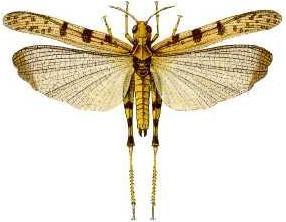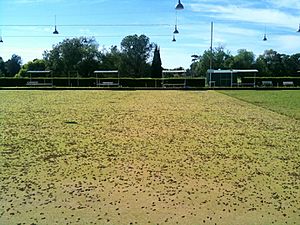Australian plague locust facts for kids
Quick facts for kids Australian plague locust |
|
|---|---|
 |
|
| Scientific classification | |
| Kingdom: | |
| Phylum: | |
| Class: | |
| Order: | |
| Family: | |
| Subfamily: |
Oedipodinae
|
| Genus: |
Chortoicetes
|
| Species: |
C. terminifera
|
| Binomial name | |
| Chortoicetes terminifera (Walker, 1870)
|
|
| Synonyms | |
|
|
The Australian plague locust (Chortoicetes terminifera) is a type of insect that lives in Australia. It belongs to the Acrididae family, which includes many types of grasshoppers. This locust is known as a major pest because it can cause a lot of damage to farms and crops.
Adult Australian plague locusts are usually 20 to 45 mm long. Their color can be brown or green. Their head is higher than their body (thorax). The thorax has an X-shaped mark. Their legs have a reddish lower part, and their wings are clear. There is a dark spot at the end of each wing.
Contents
Where They Live
Australian plague locusts naturally live in parts of New South Wales, Queensland, South Australia, and Western Australia. From these areas, they can spread to other farming regions. This includes areas in South Australia, New South Wales (like the Riverina), and Victoria.
These locusts can be found in many types of open grassy areas. Sometimes, strong winds can carry them to coastal areas. They can even reach northern Tasmania. However, these groups usually do not survive for long.
How They Grow
When it rains, new green plants grow. Adult locusts eat these plants. Within a week, they are ready to lay eggs. Female locusts use a special tool called an ovipositor to dig a hole in the soil. They lay their eggs in a group called a pod. Each pod holds about 30 to 50 eggs. A female locust can lay two or three pods, a few days apart.
Many locusts often lay eggs in the same area. Sometimes, a million eggs can be laid in just one hectare of good soil. If the weather is warm and wet, the eggs hatch in about two weeks.
Young Locusts (Nymphs)
After hatching, the young locusts are called nymphs. They take about 20–25 days to grow in summer. A locust grows through five stages, called instars. After each stage, they shed their skin (molt). Their wings become bigger with each molt.
After the first two stages, nymphs start to gather in groups. These groups are called bands. They tend to spread out by the fifth stage. Older nymph bands can travel up to 500 meters (about 1,640 feet) in a day. In dry areas, these bands can be very large. You might even see them from an airplane! In farming areas, the bands are usually smaller.
Adult Locusts
After their last molt, about 6 to 8 weeks after hatching, the locust becomes an adult. At this point, it is called a fledgling. Fledglings go through three more growth stages. First, their wings get stronger and their outer shell (exoskeleton) hardens. Then, they store up fat. Finally, they develop their eggs.
When there are many locusts, they can form huge groups called swarms. These swarms happen in central Eastern Australia every two or three years. Australian plague locusts are not as social as some other locusts. Their swarms can range from very dense groups to scattered adults. Swarms can last for days, breaking apart and reforming as they follow the wind.
A swarm can move up to 20 km (about 12 miles) in a single day. They can cover an area of up to 50 square kilometers (about 19 square miles). However, most swarms cover less than 5 square kilometers (about 2 square miles). Swarms can travel as far as 800 km (about 500 miles). They often move with hot winds, usually towards the coast.
Locust Plagues
When there is plenty of food and good weather, huge swarms of locusts can form. These are called plagues. The first recorded locust plague in Australia was in 1844. More outbreaks happened from the 1870s onwards. After 1900, the plagues became more common and intense.
Since the 1920s, a pattern has appeared. There are often small, dense groups of locusts in some places every year. Then, larger plagues happen less often. These big plagues can cover huge areas and last for one or two years. Plagues in Western Australia are not as common.
Heavy rains, especially in summer, help locusts grow into plague numbers. Less regular rain can keep these large populations going. During these times, the locusts grow faster. They can go from hatching to adult in just 2.5 months. Dry weather helps reduce the locust numbers back to normal levels.
The Australian plague locust causes the most damage of any locust in Australia. This is because they cover such a large area and have frequent plagues. They mostly damage pasture (grasslands for animals). However, they can also harm crops. Older winter crops are usually tough by early summer. This is when locusts are most active, so they are not often eaten. But young crops or those in dry conditions can be badly damaged by locusts.
How People Control Them
If locust plagues are not controlled, they can cause millions of dollars in damage. The Australian Plague Locust Commission is in charge of watching and controlling locust outbreaks. They use special chemicals to fight the locusts.
One chemical used is fipronil. They also use growth regulators like diflubenzuron on young locusts (nymphs). Sometimes, older chemicals like fenitrothion and chlorpyrifos are used for large sprayings. There is also a natural spray called 'Green Guard'. It is made from a fungus called Metarhizium acridum. This natural spray is used more often now. It is good for organic farms or places near water.
See also
 In Spanish: Chortoicetes terminifera para niños
In Spanish: Chortoicetes terminifera para niños



